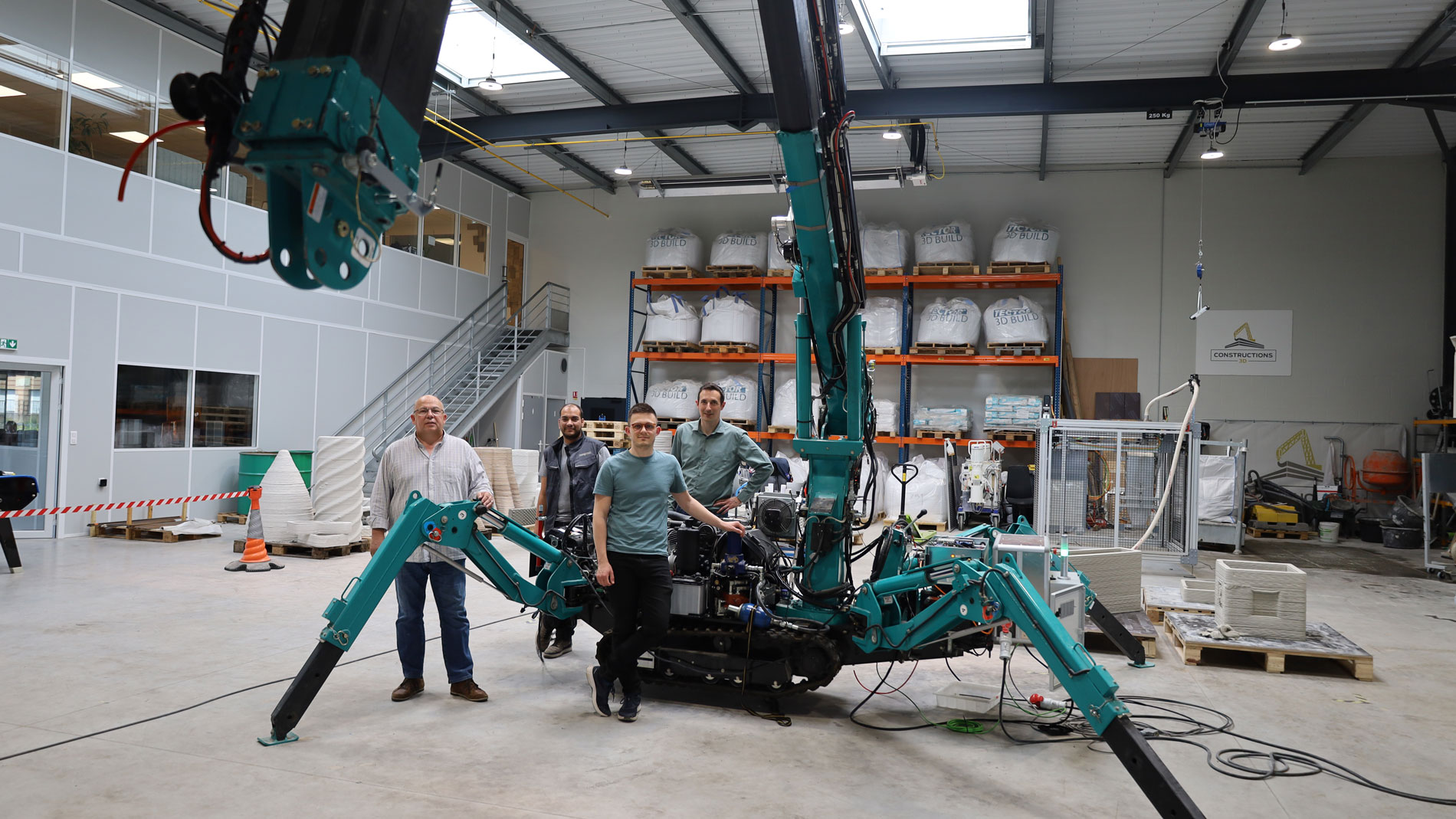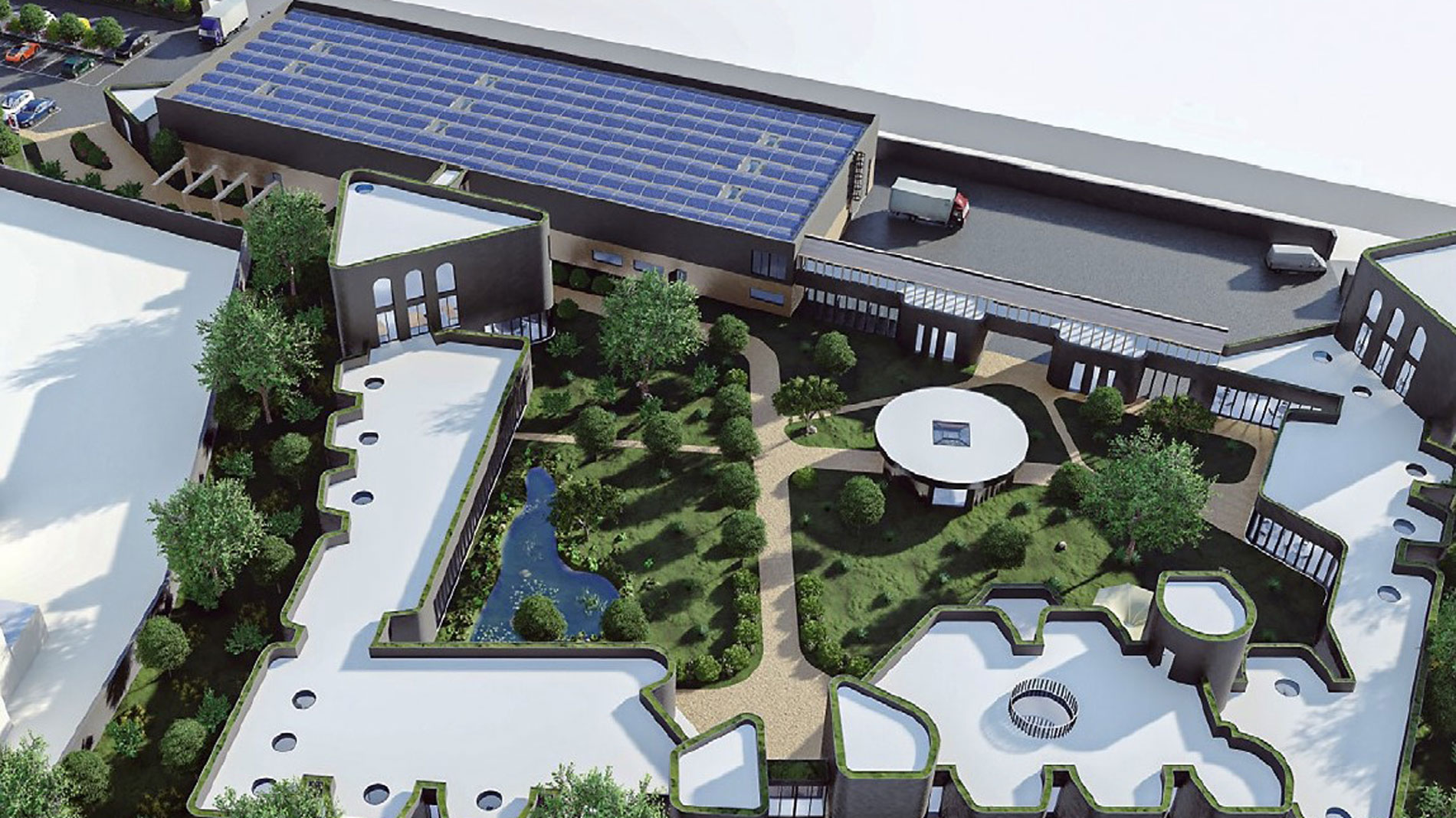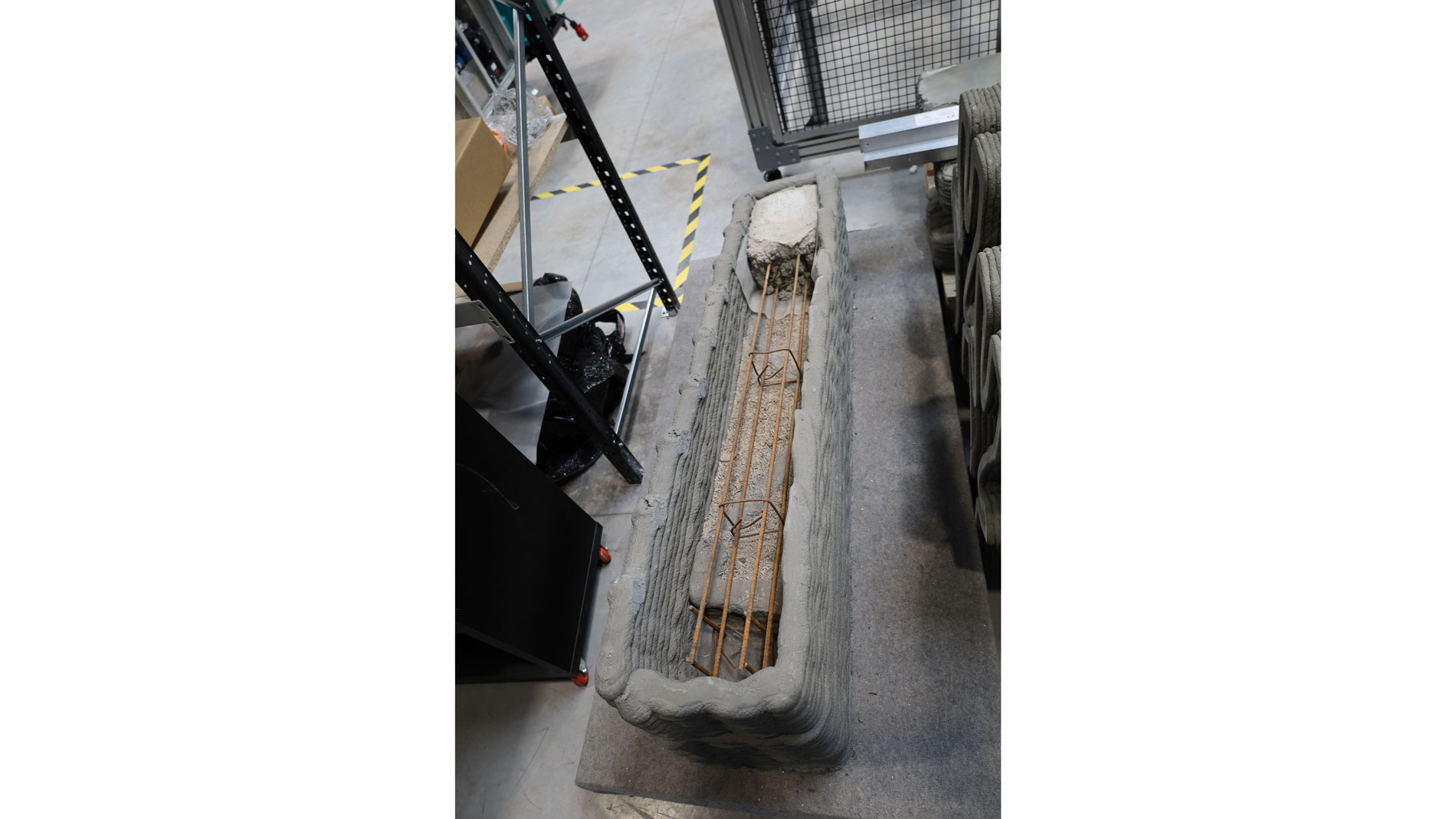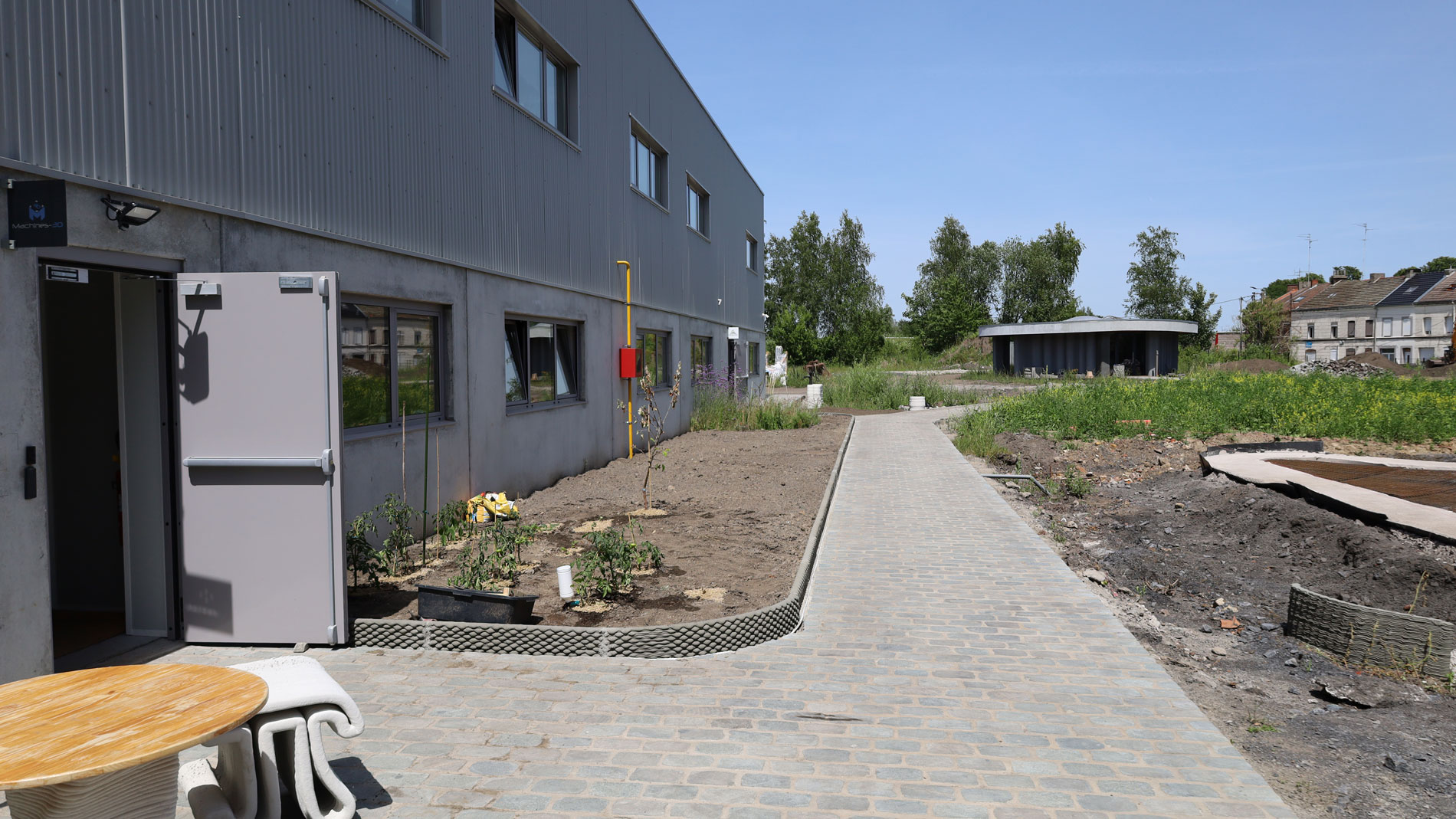11 September 2022, by Thomas Masuch
Constructions-3D, a young company from the north of France, is creating concrete 3D printers and developing its (partially additively manufactured) headquarters into a center of creativity and sustainable ideas.
Nikola Tesla, Albert Einstein, and Marie Curie are there to greet me: 3D-printed plastic busts of the three luminaries are enthroned on charging stations for electric vehicles in the parking lot of Constructions-3D in the northern French city of Valenciennes. The stations themselves are also 3D-printed, as is the entrance portal to the production and office building. And when I enter the building, the journey through the world of AM continues: at the reception counter printed from concrete; the replica of the city of Minas Tirith (from The Lord of the Rings) that passes on my left; and the Indian busts, jungle palace, and pantheon of Greek gods I encounter – all of which came from a 3D printer.
The roughly 10-meter-high exterior walls of Constructions-3D's corporate headquarters are adorned with the name “Citadelle des Savoir-Faire”, meaning “fortress of knowledge and making”. Inside, Antoine Motte, Axel Théry, and their team are standing next to a concrete 3D printer measuring around two-by-two meters, which is performing a test print around one meter high. Its precisely controlled nozzle repeatedly travels along the contours, each time placing another length of thick concrete slurry on top of the one before. After about 15 minutes, the work – the front of which features the carved-out name “Constructions-3D” – is completed, and two colleagues carefully pull out the pallet bearing the still-unstable structure. "Such tests are immensely important for us, as they allow us to improve our own development while documenting the stability of 3D-printed objects," explains Théry, co-founder and engineering manager at Constructions-3D. He’s controlling the printing parameters and construction process from his laptop, and urges me to hurry along. "The cement in the system's hoses dries very quickly, so we have to continue with the next test print right away,” he explains.

From cranes to 3D printers
A few meters further on, a steel spider spanning around five meters and weighing several tons occupies the hall. The MaxiPrinter is a flexible concrete 3D printer which can be transported entirely in a container. It’s Constructions-3D’s main product, and one with which the French company wants to shake up the construction industry.
The technology is based on a chain-driven crane. "However, this is pneumatically driven and actually quite inaccurate," explains Théry. "Our task over the past few years has been to make the pneumatics precise. That's a big challenge because this kind of technology is made to be strong, robust, and able to withstand the weather on jobsites.” In addition to the necessary technical modifications, Constructions-3D also developed its own control software. Just how big a challenge it was to turn such a heavy-lifting roughneck into a precise 3D printer was also demonstrated by the reaction of the Japanese manufacturer of the crane in question. "At first, the Japanese thought we were crazy," recalls Antoine Motte, co-founder and CEO of Constructions-3D, "but now they appreciate us because we've bought quite a few of their cranes in the meantime."
Meanwhile, Antoine Motte and his team have brought the MaxiPrinter to market maturity and delivered a number of units. In a fairly young but already competitive space, Motte cites the MaxiPrinter’s quick assembly (it takes no more than two hours) and compact design as advantages. "Assembled, it fits through a hinged door and can also print indoors,” he points out. In addition, the company offers smaller concrete printers: the MiniPrinter PRO, which is suitable for things like furniture or medium-sized concrete parts, and the MiniPrinter EDU, which is used primarily in vocational schools.




From reselling printers to 3D-printing houses
In the beginning, Constructions-3D’s ambitious and very determined development was also shaped by chance: Antoine Motte had already founded Machines-3D, a reseller of desktop 3D printers, in Belgium in 2013. After moving to Valenciennes, the company grew rapidly and reached around 10 employees in three years. To date, the company – which is also housed in the Citadelle des Savoir-Faire – has maintained that size. For a trade show appearance, the team built a concrete 3D printer for demonstration purposes using many 3D-printed components. "It wasn't so much to show our involvement in the construction industry, but to show what you can do with our 3D printers,” Motte reveals. This small 3D printer, which still stands as a model not far from the assembly station of the giant MaxiPrinter, was the unexpected prelude to entering a whole new business field. Initial contacts were made with the construction industry, the original model was developed further, and 2017 saw the official founding of Constructions-3D. Motte holds a majority stake in the company, but with Axel Théry, civil engineer Antoine Urquizar, and senior sales manager Didier Malbranque, the founding team is also involved. Constructions-3D now employs 15 people and plans to have 20 by the end of 2022.
In 2019, the company's first 3D-printed building was created. “The Pavillon” now stands just a few meters away from the production hall and can be reached via a small path bordered by 3D-printed curved curbstones. Along the way, you pass a narrow garden where employees each cultivate a small plot of flowers, fruit, or vegetables. A small corner with tables and benches – also 3D-printed from concrete, of course – invites you to linger.
The circular pavilion, which consists of a 3D-printed wall and a wooden roof, was a project fraught with some uncertainty three years ago. "There was no concrete optimized for 3D printing yet," says Antoine Motte, "but if you don't take risks, you won't be the first." For its next 3D-printed buildings, such as the entrance hall of the Citadelle, the Constructions-3D team had already developed the necessary manufacturing expertise: For the walls, three vertical layers are printed to form two hollow segments. These are each filled with concrete and flax, which provide a good combination of stability and insulation. Flax is a material that has been used in the Hauts-de-France region "as far back as the Middle Ages, and doesn’t get eaten by rodents and insects," says Motte. Additional stability can be achieved by reinforcing the concrete segments with structural steel.

No problems with building permits
For Antoine Motte, 3D-printing concrete was a return to familiar territory, as the 38-year-old trained civil engineer had already worked in the construction industry for eight years before founding Machines-3D. In the process, the father of three was also able to put his extensive experience in dealing with the authorities to good use, which helped him obtain permits for his 3D-printed buildings without any major problems. "The city mainly checks things like wall thickness, fire safety, and the number of parking spaces," Motte said. "In France, you don't really have to specify the technology that will be used in construction."
However, the relative ease of planning of 3D-printed buildings currently only applies to self-financed properties in France. According to Motte, the situation is different for externally financed projects: "Here, banks will probably demand proof that the technology to be used is mature and reliable enough." To remove the bottleneck in AM’s further development in the construction industry, Constructions-3D creates test prints and tests them for strength in its laboratory on a regular basis.
For these tests, Antoine Urquizar has specifically designed a test machine called Constructimeter that repeatedly examines the strength of a freshly printed “concrete cake” at intervals of a few minutes. This can then be used to predict not only stability, but the optimum printing speed, as well. Constructions-3D has now also brought the machine to market as a quality assurance product for customers like concrete manufacturers, which use it to test their materials. "For us, it's not about making profits at all, but about growing the market. That’s the only way we’ll be successful as a company and fulfill the goals we’ve set ourselves," says Antoine Motte.








A future beyond the traditional construction industry
In addition to the technical challenges at hand, Antoine Motte sees a lot of other work ahead, especially in the construction industry and the field of potential applications. The conventional construction industry, he says, has a very traditional attitude and is very difficult to win over with new technologies. "The market isn’t yet well developed, and its development is currently dominated by somewhat crazy masterminds – those who bought a Tesla five years ago," Motte smiles. "So in the future, most of our customers will probably come from other industries that are more open to innovation and shaking up the construction industry." The OVH Group, for example – Europe's largest cloud provider – has ordered a MaxiPrinter to build a new data center itself.
Constructions-3D also wants prospective users to get more ideas at the Citadelle des Savoir-Faire. Around the current production and office hall, the company has purchased a 2,500-square-meter area that will be filled with 3D-printed buildings for offices, production, and development over the next few years. The next of these will be an 11-meter office tower, the foundation of which was already unveiled in June 2022. This is set to become the world's tallest 3D-printed building according to Constructions-3D, which is financing its ambitious growth itself. Ultimately, however, the success of its products is what will enable the company’s further development. "Through the sale of our small machines, we finance the development of the large ones, and through the sale of the large ones, the development of the Citadelle," explains Motte. In general, however, it's not the availability of money that's the challenge, but “getting the right people."
As a home for talent, the rather tranquil Hauts-de-France has been a good address. "We have good universities here and good transport routes, including via the river Scheldt, which enables us to ship our machines and materials." In addition, France offers excellent research facilities and a strong cement industry, thus providing ideal conditions for growth.
Much more than technology and business
To tell the story of Constructions-3D in technical and business terms alone would leave it far from complete; it’s also a story of ideas, historical references, and philosophies. This isn’t meant to give the impression that the company is a hive of unbridled creativity, though. On the contrary, its halls and offices are among the tidiest and cleanest I have visited.
To move one step closer to sustainable 3D printing, this year Constructions-3D developed a recipe for a material (Thermix 3D) that primarily comprises locally available products such as clay, straw, and residual materials from the company’s foundry that would otherwise be disposed of as waste.
In addition to sustainability, Motte is bubbling over with other ideas. They include resurrecting the Elephant of the Bastille, which Napoleon actually wanted to erect as a monument on the Place de la Bastille in Paris around 200 years ago. Later, only a plaster model about 10 meters high was created and eventually immortalized in Victor Hugo's Les Misérables as a home for the ragamuffin Gavroche. As a metaphor for Constructions-3D's corporate goal, the elephant is to be recreated in 3D-printed form in the Citadelle des Savoir-Faire.
FURTHER INFORMATION:
Tags
- Sustainability
- Additive Manufacturing
- Construction and architecture
